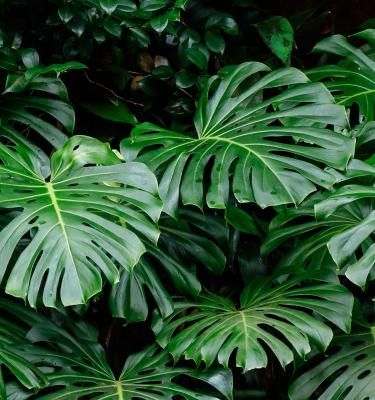

How to care for a Monstera plant
What would a stylish living room be without a Monstera taking pride of place? This eye-catching green plant with its large, split leaves has become a favourite in the Urban Jungle trend. Why not embrace the look yourself? Easy to care for and endlessly decorative, the Monstera brings beauty and benefits to your home. Here’s how to care for your Monstera deliciosa.
All about Monstera deliciosa
Monstera deliciosa, also called the Swiss cheese plant, originates from tropical jungles where it can climb up to 15 metres high. Its exotic heritage explains why it thrives indoors. It needs temperatures of between 18-25°C to thrive and prefers indirect light (i.e. a bright position out of direct sunlight) but will also cope with direct light filtered through blinds or curtains.
This evergreen plant is prized for its large leaves, which can grow up to 1 metre wide with perfect conditions. As the plant matures, the leaves develop characteristic splits and holes which give the plant its name of Swiss cheese plant. In the wild, these holes in the leaves allow sunlight to reach the lower leaves. Monsteras are natural air purifiers, capable of absorbing common air pollutants like formaldehyde, benzene and trichloroethylene that are emitted by household products.
Outdoors, Monsteras may even flower and produce fruits. The fruits are edible when ripe, but unripe fruits are toxic. However, since indoor plants are very unlikely to flower, this isn’t something to worry about! Indoors, a mature Monstera can reach heights of up to 3 metres, making it a striking addition to any room.
NB: Monstera plants are toxic to cats and dogs, so keep them out of reach if your pets are prone to nibble your plants.
Popular Monstera varieties
While the classic Monstera deliciosa is well-loved, there are several other appealing varieties:
- Monkey Mask (Monstera adansonii): This playful variety has smaller leaves with perforations resembling a monkey’s face. It’s less vigorous than Monstera deliciosa, growing to between 1-2m tall, so it’s good for smaller homes.
- Monstera deliciosa ‘Variegata’: A stunning cultivar with cream and green variegated leaves. Growing to 3m or more, it’s a showstopper in any home.
Monsteras are perfect as standalone statement plants but also pair beautifully with orchids, with the bold Monstera leaves being a great contrast to the delicate orchid flowers.
Monstera deliciosa plant care
Monstera deliciosa plants are easy to care for, even if you’ve never grown one before. Here’s our beginner’s guide to Monstera care.
Pruning Monstera plants
_0.jpg)
To manage your Monstera’s growth, prune in spring, removing any leaves that are too large or are unbalancing the plant.
Monstera aerial roots are a normal part of the plant’s growth. These can be left on the plant or cut off at the base of the aerial root.
If you have enough space, let your Monstera grow freely to create a fabulous tropical effect. Use a soft plant tie to attach the Monstera to a moss pole. This will support the stems and give the plant something to climb up.
How to propagate Monstera deliciosa in water
It’s easy to grow Monstera from stem cuttings in water– just follow these simple steps:
- Choose a healthy stem at least 15cm (6in) long with a few leaves growing from it. When cutting monstera stems for propagation, cut just below a node (the point where a leaf joins the stem).
- Place the monstera cutting in water.
- Change the water every 2-3 days.
- Once roots have developed (about 2-3 weeks), repot the cutting into houseplant compost and grow on.
Feeding your Monstera
Feed your Monstera regularly during the growing season, using a balanced liquid houseplant feed. To judge how often to feed, start by feeding monthly and watch your plant’s growth. If it is not producing new leaves, or if the leaves are turning yellow, increase the feeding frequency.
Dusting Monstera leaves
Gently wipe the large leaves with a soft cloth to remove dust. This not only enhances their appearance but also allows the plant to absorb more light.
Watering your Monstera
Water your Monstera regularly from spring to autumn but allow the compost to almost dry out between waterings to avoid root rot. Water less frequently in winter.
In hard water areas, use rainwater or filtered water.
Monsteras dislike sitting in water, so always empty excess water from saucers or cache-pots. The plant’s roots can easily rot if left to sit in wet compost for long periods.
Humidity matters
Monsteras are tropical plants and prefer a humid environment. Indoor heating during winter can dry out the air, which Monsteras don’t tolerate well. To maintain humidity levels around the plant, mist the leaves and aerial roots regularly.
Placing a bowl of water near the plant can also help to raise humidity levels around the leaves.
Pests and diseases
- Yellowing leaves: The most common cause of Monstera leaves turning yellow is nutrient deficiency. This can happen when the plant is rootbound and needs a bigger pot. Over- and under-watering can also cause leaf yellowing because they affect the roots’ ability to take up nutrients. Check your plant’s compost regularly to ensure you are giving it the right amount of water, and repot every couple of years.
- Leaves turning brown and crispy: Monstera leaves turning brown and crisp at the tips can be a sign that the air is too dry. Mist the leaves daily, using rainwater or soft water, and place a bowl of water near your Monstera to raise the humidity level around the leaves.
- Common pests:
- Aphids and whiteflies: Look for small green or white bugs on the leaves, as well as curled leaves or sticky residue. Wipe the pests off with a cloth or spray with insecticide.
- Spider mites: These are recognisable by mottling on upper leaf surfaces, as well as fine webbing on heavily affected plants. Move affected plants away from other houseplants, and spray with insecticide.
- Mealybugs: Check for white, cottony patches on stems and leaves. Treat with insecticide or insecticidal soaps containing fatty acids.
By staying vigilant and addressing issues promptly, your Monstera will remain a stunning centrepiece for years to come.



